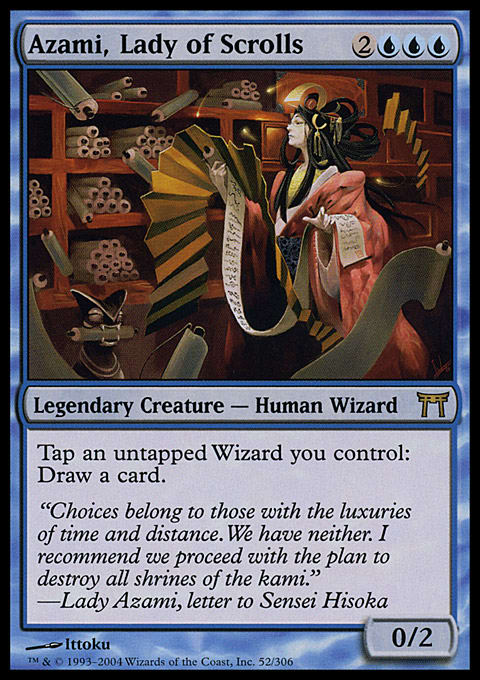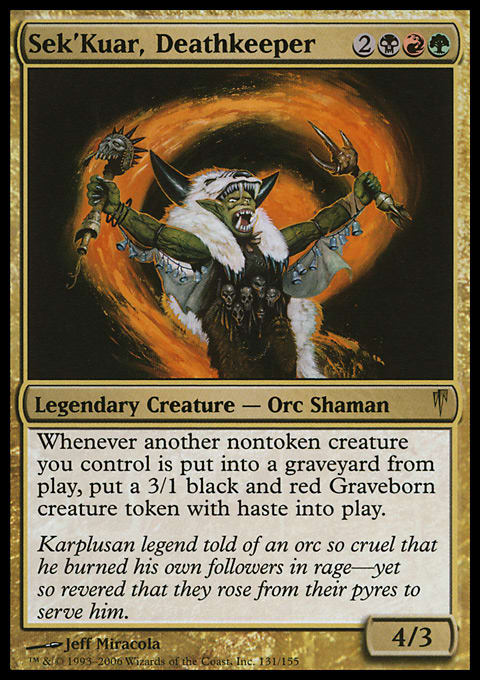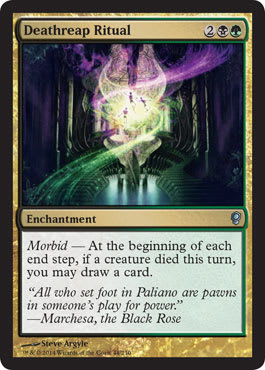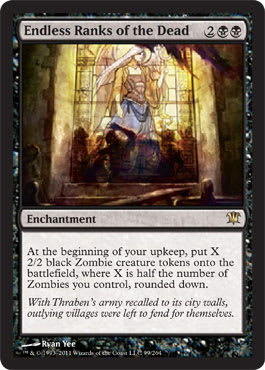When I moved back to Brooklyn, I was quick to find my way into the revitalized local Magic scene. I yearned to draft and play Commander. I wanted to make new friends. I sought out the local game store. After attending a few events and getting on some e-mail lists, I put out feelers for other people with stacks of ninety-nine.
One person replied. An e-mail appeared in my inbox of a shadowy portrait complete with a cat. It was from this person that I learned about a group of people who met in a basement bar on Monday evenings and played Commander while loud jazz blared in the background.
The person is Jess.
Over the next few years, we would game frequently and corresponded often. Jess and I shared many interests in Magic, including Commander, Pauper Cubes, and writing. We would have discussions that I always wanted to keep going but were cut short due to real-life responsibilities.
Jess is a hell of a writer. The work she’s published on Hipsters of the Coast merges real-world issues and ideas of conflict and power with the dynamics of multiplayer. Since she has taken over alternating weeks of Dear Azami, I have found her insight into different mindsets to be enlightening.
Jess challenges not only my notions around the card table, but also in life. Engaging in conversation with Jess has made me look at things I once held true and reevaluate them. I like to think that our friendship has made me a better person.
But this quote . . . This might be the best part.
I have long been a fan of Cockroach strategies in Commander. The idea of sitting back and generating an advantage simply from taking my turns plays into my overarching strategy when it comes to the multiplayer table. I guess no deck exemplifies this more than my Sek'Kuar, Deathkeeper (a deck for which Jess got me a foil copy of the Orc in charge):
Sek'Kuar, Deathkeeper ? Commander | Alex Ullman
- Commander (0)
- Creatures (49)
- 1 Agent of Erebos
- 1 Anger
- 1 Ashen Ghoul
- 1 Blood Artist
- 1 Butcher of Malakir
- 1 Cackling Fiend
- 1 Carrion Feeder
- 1 Cemetery Reaper
- 1 Corpse Connoisseur
- 1 Corpse Harvester
- 1 Crater Hellion
- 1 Creakwood Ghoul
- 1 Death Baron
- 1 Deathbringer Thoctar
- 1 Falkenrath Noble
- 1 Fleshbag Marauder
- 1 Golgari Guildmage
- 1 Graveborn Muse
- 1 Gravecrawler
- 1 Gravedigger
- 1 Grim Haruspex
- 1 Krovikan Horror
- 1 Lord of the Undead
- 1 Massacre Wurm
- 1 Noxious Ghoul
- 1 Overseer of the Damned
- 1 Pharika's Mender
- 1 Phyrexian Delver
- 1 Rage Thrower
- 1 Reassembling Skeleton
- 1 Reclamation Sage
- 1 Shriekmaw
- 1 Skinrender
- 1 Stronghold Assassin
- 1 Undead Gladiator
- 1 Veilborn Ghoul
- 1 Vengeful Dead
- 1 Vengeful Pharaoh
- 1 Woebearer
- 1 Wood Elves
- 1 Yavimaya Granger
- 1 Zealous Conscripts
- 1 Solemn Simulacrum
- 1 Geth, Lord of the Vault
- 1 Ghoulcaller Gisa
- 1 Jarad, Golgari Lich Lord
- 1 Mogis, God of Slaughter
- 1 Purphoros, God of the Forge
- 1 Tymaret, the Murder King
- Spells (14)
- 1 Call to the Grave
- 1 Deadbridge Chant
- 1 Deathreap Ritual
- 1 Endless Ranks of the Dead
- 1 Fires of Yavimaya
- 1 Goblin Bombardment
- 1 Grave Pact
- 1 Keldon Twilight
- 1 Necromancer's Stockpile
- 1 Perilous Forays
- 1 Tortured Existence
- 1 Warstorm Surge
- 1 Chromatic Lantern
- 1 Phyrexian Altar
- Lands (36)
- 4 Mountain
- 5 Forest
- 7 Swamp
- 1 Akoum Refuge
- 1 Blood Crypt
- 1 Bloodfell Caves
- 1 Command Tower
- 1 Golgari Rot Farm
- 1 Jungle Hollow
- 1 Kazandu Refuge
- 1 Overgrown Tomb
- 1 Rakdos Carnarium
- 1 Rootbound Crag
- 1 Rugged Highlands
- 1 Shivan Oasis
- 1 Stomping Ground
- 1 Temple of Abandon
- 1 Temple of Malady
- 1 Temple of Malice
- 1 Unholy Grotto
- 1 Urborg Volcano
- 1 Tresserhorn Sinks
- 1 Tombstone Stairwell
Sek’Kuar leads a shambling horde into battle. Being comprised mainly of creatures, the best avenue of attack to keep me down is to simply keep them off the board. Doing so is a real way to preventing this deck from establishing any sort of winning position.
Or at least that’s what I want you to think.
I let opponents think they’re making progress; meanwhile, I’m simply assembling a way to win.
Often when piloting this deck, I will come out of the gates and start building up a mass of Zombies. In this way, I set myself up as an early threat so I draw early ire. This, in turn, leaves me without much of a presence and gives me the opening I need to start working on my actual path to victory.
Creatures are fragile things, and they are meant to die. Commander decks, at least where I play, are loaded with ways to deal with creatures. And with good reason: Attacking wins games. Sek’Kuar is loaded with tiny creatures that are annoying, but hardly the same threat as say a Craterhoof Behemoth. Rather, the strong Zombie theme means that the creatures work better in concert. This is all part of the plan as taking out any creature weakens their overall threat level.
It is all deception, however. Cards like Blood Artist and Falkenrath Noble demand that all men must die. Grim Haruspex gets in on this action as well. The truth is, of course, that I want things to hit the graveyard—it is how my deck generates value. By playing out my hand early, I force kill spells my way before Sek'Kuar, Deathkeeper can hit the table. If my commander is active, killing monsters becomes a far less attractive option. Instead, this deck is set up so things will meet an early end so I can establish my true foothold.
That weakness, though, has to be real. I tend to find myself with a low life total, barely holding on, but alive enough that killing me would leave someone else with his or her shields down. It is at this point when I can successfully send my opponents against each other while I go to work.
Artifacts and Planeswalkers are easy targets. Enchantments, for some reason, rarely draw the same amount of vitriol as other permanent types. That works to my advantage.
Once my creatures are dead, I am able to start playing out the numerous enchantments that help make this deck hum. Deathreap Ritual keeps the cards flowing. Grave Pact and Call to the Grave keep everyone else down as well. These two, however, appear threatening. The goal is to keep something small, say a Gravecrawler, around, to keep these active without actually presenting a threat. Goblin Bombardment helps to keep creatures dying—1 damage does not look like a lot, and it rarely is (unless it kills someone). Tortured Existence lets me bring back key creatures that once died.
At this point, I am not a threat. Victory over me is all but assured. Then, the undead horde comes knocking.
Using Jess’s quote as a guide, I let my adversaries have some false victories. I am dealt damage and hang at a precariously low life total. My graveyard is full of creatures—sometimes, it has even been exiled. I am not a threat.
It can come in dribs and drabs, but the end result is the same: Assemble a game-winning combo. Purphoros, God of the Forge and Rage Thrower are two of the best when used in conjunction with Gravecrawler, another Zombie, and Phyrexian Altar. I simply cast the Zombie enough times to kill everyone. Goblin Bombardment also works nicely, and if a Blood Artist is on the table, I am able to boost my own life total all the while. Unassuming creatures like Carrion Feeder and Golgari Guildmage go from interesting choices to integral pieces of my win condition. When the dust settles, the victory from my morbid army is rather real.
Of course, that is all another aspect of the deceit. The deck can also shift into a true swarm thanks to Sek’Kuar, Ghoulcaller Gisa, and Endless Ranks of the Dead. Anger and Fires of Yavimaya makes attacking for the win with a ton of tokens a very real possibility. Against people who have battled me before, focusing on the enchantments is only correct if I want it to be correct.
Deception is more than just convincing other people that you are not the biggest threat at the table. It is a core element in the deck-building process. A successful Commander deck has to be able to win on multiple levels. It should be able to have its most straightforward path to victory, whatever it may be, but it should also have elements that can end a game in Plan B. These strands can be linked, but if one distracts from the other, you position yourself in such a way that it keeps the other players off balance.
The goal, of course, is to be the last player standing. Letting other players take the hill is fine if you take the mountain. The cockroach style of play is uniquely set up for this since it slowly accumulate resources over the course of turns. The tiniest threat is often the one that ends up mattering the most—another deception.
Jess gives much to the world of Magic, but that quote . . . It may be the best thing she ever gave me.
Thanks, Jess. See you next time we battle.


























